
Identification Practice for the
Dixon Christmas Bird Count
Species observed in
16
15
14
13
12
11
10
9-8
7-6-5
4-3-2
1
out of 16 years of the count.
This Learning-Feature was developed for the 2013 CBC season. As we prepare for the 2019 season, we now have 22 years of data. (See Updated Compilation)
This feature stresses the most commonly occuring species, so there is little change in the relative frequencies of those species.
A good preparation for the 2019 count is still provided.
An update of this feature will take place at a later date.
English Name:
Genus species: | Comments | Photos |
| Swans, Geese and Ducks |
Mallard
Anas platyrhynchos
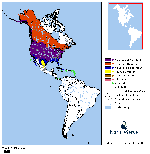
Enlarge Map
External Sites:
Cornell
USGS
Image Search | Note white horizontal mark at rear on both Female (above)
and
Male (below).
Male plumage distinctive. | 
Rinconada
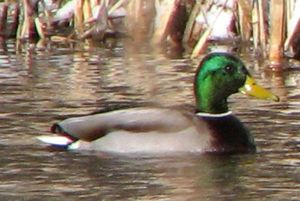
Rinconada |
Common Goldeneye
Bucephala clangula
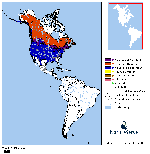
Enlarge Map
External Sites:
Cornell
USGS
Image Search | Females (upper) have brown heads.
Male (below) has dark head with distinctive white patch between the bill and the eye.
Both have yellow eye. | 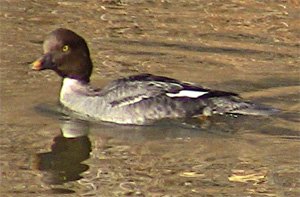
Orilla Verde
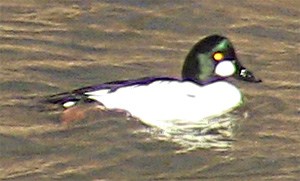
Orilla Verde
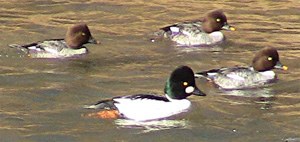
Orilla Verde Enlarge
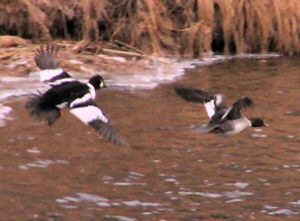
Rinconada |
Common Merganser
Mergus merganser
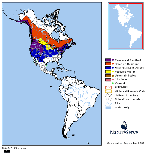
Enlarge Map
External Sites:
Cornell
USGS
Image Search | Distinctive bill shape and color.
Male has dark head.
Female reddish-brown head. | 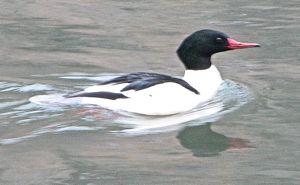
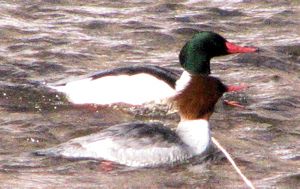 |
| Long-legged Wading Birds |
Great Blue Heron
Ardea herodias
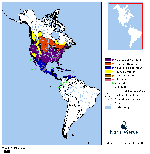
Enlarge Map
External Sites:
Cornell
USGS
Image Search | Only Winter Heron.
Large, often standing in water.
In flight: 72" wingspan. | 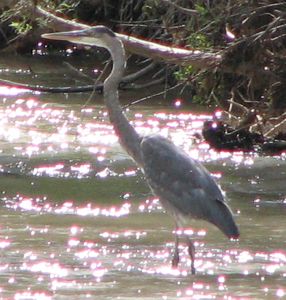
El Bosque

El Bosque |
| Diurnal Raptors: Vultures, Eagles, Hawks and Falcons |
Bald Eagle
Haliaeetus leucocephalus
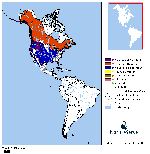
Enlarge Map
External Sites:
Cornell
USGS
Image Search | Adult: Distinctive white head and tail.
Juveniles have white in wings near body. Sometimes head brown and tail with brown band on trailing edge. | 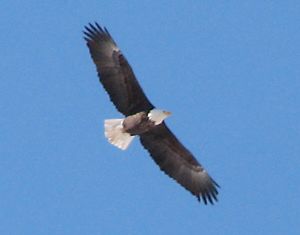 |
Red-tailed Hawk
Buteo jamaicensis

Enlarge Map
External Sites:
Cornell
USGS
Image Search | Often easily identified by visible red tail.
If tail is not visible, other field marks can be used:
From below in flight, the dark front edges of the wings next to the body and the dark "commas" at the wrist are unique among local hawks.
When perched, the dark belly band against the white front is diagnostic.
Juveniles (lowest photo) do not yet have a red tail. | 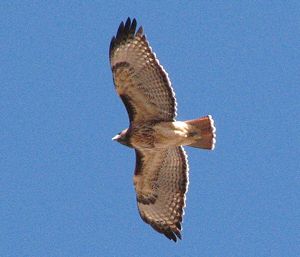
El Bosque
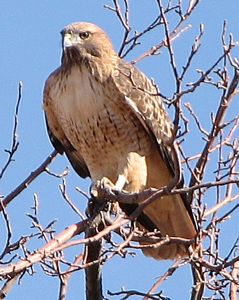
El Bosque
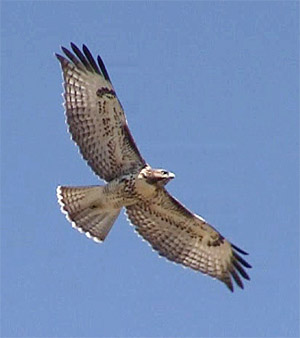
Camino Lejo, Santa Fe |
| Pigeons and Doves |
Rock Pigeon
Columba livia
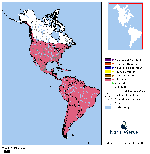
Enlarge Map
External Sites:
Cornell
USGS
Image Search | Common on wires around human habitation, this species comes in a variety of colors.
Most individuals show two dark wing bars as shown in the upper photo. | 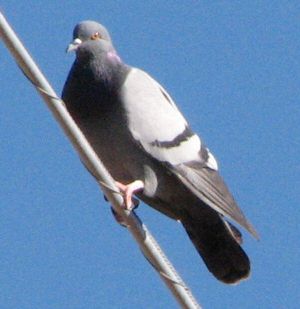
Cañoncito
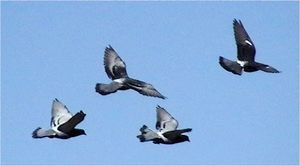
El Bosque |
| Woodpeckers |
Downy Woodpecker
Picoides pubescens
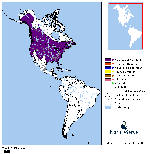
Enlarge Map
External Sites:
Cornell
USGS
Image Search | Almost identical to the Hairy Woodpecker in plumage, this smaller woodpecker is generally distinguished by its diminuitive bill which is much shorter than the bird's head from front to back.
The red patch on the head indicates that this is a male. | 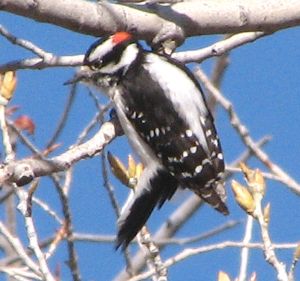
El Bosque |
Northern Flicker
Colaptes auratus
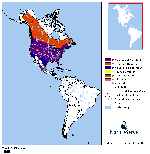
Enlarge Map
External Sites:
Cornell
USGS
Image Search | One of the most common birds in the valley.
From below, shows red feather shafts in flight.
The upper photo shows key marks:
Black breast band.
Red feather shafts on underside of wings and tail.
Red mark under the eye indicates a male.
Female (middle photo): no red face mark.
Lower photo shows diagnostic white rump patch which is always visible in flight and sometimes visible when perched. | 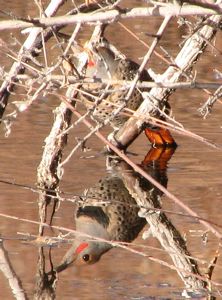
Cachanillas
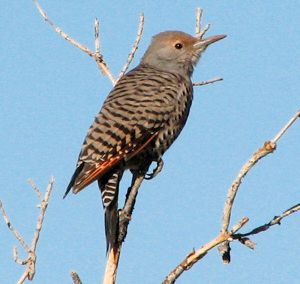
El Bosque
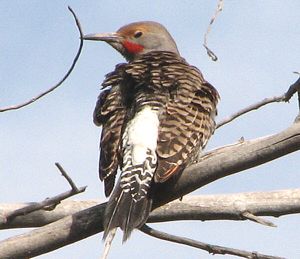
El Bosque |
| Jays, Crows and their Allies |
Western Scrub-Jay
Aphelocoma californica
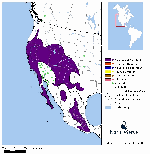
Enlarge Map
External Sites:
Cornell
USGS
Image Search | Common in all area habitats.
Note white throat and faint white eyebrow.
Also brownish-gray back.
Distinguished from the Pinyon Jay by longer tail and solitary behavior. | 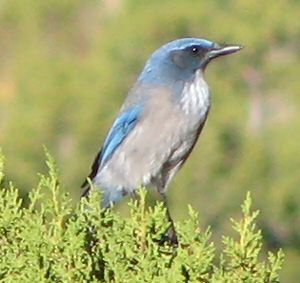
Arroyo la Mina
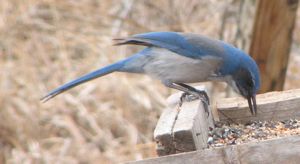
Cañoncito |
Black-billed Magpie
Pica hudsonia
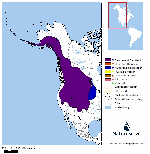
Enlarge Map
External Sites:
Cornell
USGS
Image Search | Unmistakable large black and white bird with very long tail. | 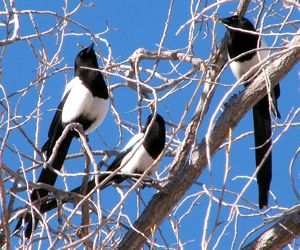
El Bosque |
American Crow
Corvus brachyrhynchos
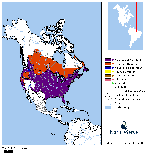
Enlarge Map
External Sites:
Cornell
USGS
Image Search | At times difficult to distinguish from Common Raven as the largest Crows are nearly as big as the smallest Ravens.
By sound, the crow's "caw" is familiar.
In flight, the crow's tail is often square or rounded.
Crows are very social and often appear in noisy groups.
Bill smaller and thinner than that of the Raven. | 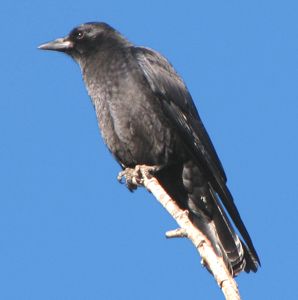
El Bosque |
Common Raven
Corvus corax
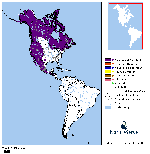
Enlarge Map
External Sites:
Cornell
USGS
Image Search | At times difficult to distinguish from American Crow.
By sound, a throaty chortle or shout.
In flight, the tail often appears wedge shaped.
Ravens are often solitary, but sometimes appear with a few other individuals.
Often soars like a hawk. Crows do not.
Bill is thick and heavy. The throat is shaggy compared to the Crow.
Breeding pairs perform synchronized flight high overhead. | 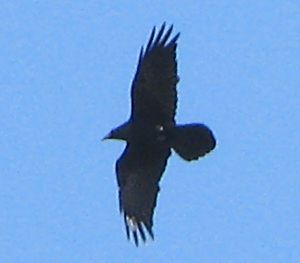
El Bosque
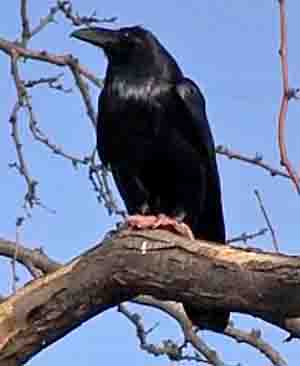
Camino de los Marquez, Santa Fe |
| Chickadees and their Allies |
Black-capped Chickadee
Poecile atricapillus
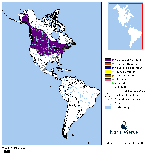
Enlarge Map
External Sites:
Cornell
USGS
Image Search | Distinctive Small (~5in) black, white and gray bird that says its name repeatedly: a buzzy chick-a-dee-dee-dee
During breeding season, gives a high descending two pitched
fee-bee. | 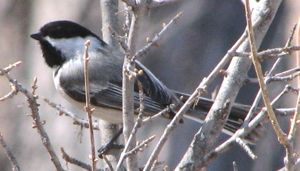
El Bosque |
| Nuthatches and Creepers |
White-breasted Nuthatch
Sitta carolinensis
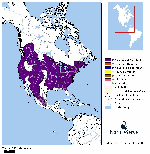
Enlarge Map
External Sites:
Cornell
USGS
Image Search | Distinctive black cap starts above the eye.
Relatively long, sharp bill.
Only local species that walks down tree trunks upside down.
Often heard at a distance: Rapidly repeated nasal "huh". Usually 5-8 sounds, all at same pitch. | 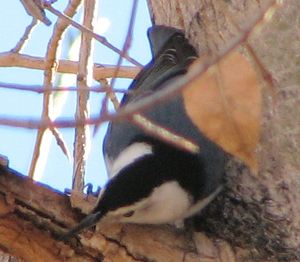
El Bosque
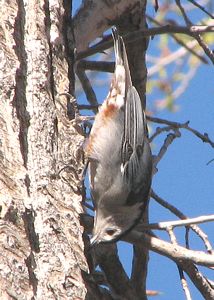
El Bosque |
| Dippers |
American Dipper
Cinclus mexicanus
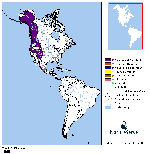
Enlarge Map
External Sites:
Cornell
USGS
Image Search | Slate-colored bird seen in rushing streams.
Often standing on rocks right at the water level, bobbing by bending its knees.
Feeds by walking on the bottom of the stream. | 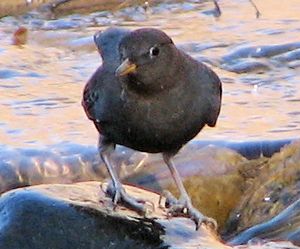
El Bosque
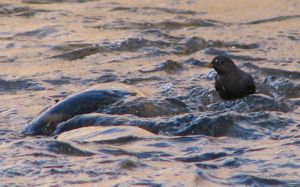
See Slide Show of Dipper Feeding |
| Kinglets and Gnatcatchers |
Ruby-crowned Kinglet
Regulus calendula
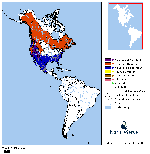
Enlarge Map
External Sites:
Cornell
USGS
Image Search | In the summer, this species is found breeding at higher altitudes. Singing individuals are very common in nearby high mountain forests such as Amole Canyon above Vadito.
The species winters in the Dixon/Embudo area where it is usually heard before seen, making a harsh, attention getting "juh-juh" in shrubs and low trees along the Río Embudo. | 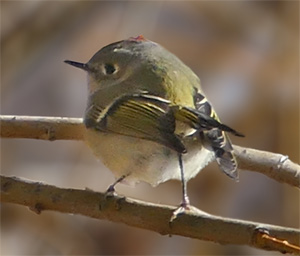
Taos, Photo: John Lay Enlarge |
| Thrushes and their Allies |
Townsend’s Solitaire
Myadestes townsendi
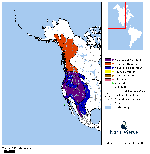
Enlarge Map
External Sites:
Cornell
USGS
Image Search | This bird is most often observed sitting in the tops of trees sounding a repeated, high, slow whistle.
Gray all over with white on sides of tail.
Fluttery in flight, with cream-colored bands running the length of each wing on the underside. | 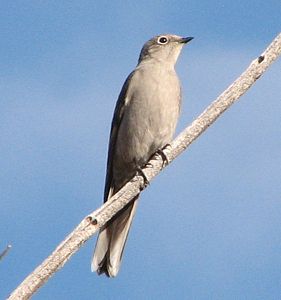 |
American Robin
Turdus migratorius
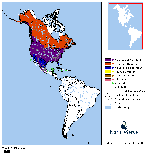
Enlarge Map
External Sites:
Cornell
USGS
Image Search | Best known American Bird.
Note reddish breast, light colored bill and large white split eye-ring. | 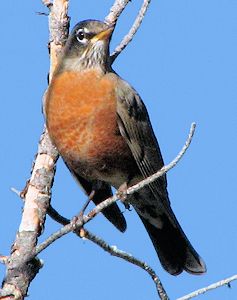
El Bosque |
| Starlings and Mynas |
European Starling
Sturnus vulgaris
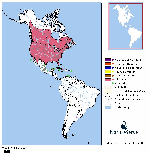
Enlarge Map
External Sites:
Cornell
USGS
Image Search | Usually appears black.
Often seen flying in large flocks. Flocks move very quickly, changing directions often.
Very short tail is distinctive among "blackbirds".
Note bright yellow bill. | 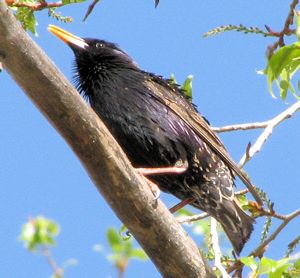
El Bosque |
| Towhees |
Canyon Towhee
Pipilo fuscus
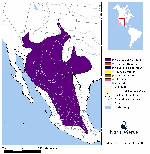
Enlarge Map
External Sites:
Cornell
USGS
Image Search | Often seen around wood piles and under parked cars.
Note the buffy cap on head and buffy feathers under the tail.
Dark central spot visible on breast. | 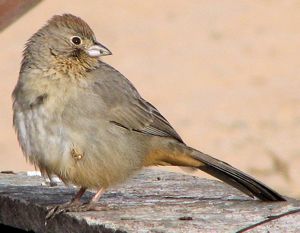
La Bolsa |
| Sparrows and their Allies |
Song Sparrow
Melospiza melodia
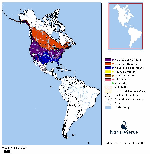
Enlarge Map
External Sites:
Cornell
USGS
Image Search | This sparrow is rarely seen more than 50 yards from the river and is often right in the willows at the river's edge.
Dark back, with streaks on breasts and sides joining a dark central spot.
Has a distinctive flight highlighted by a fairly long, rounded tail. | 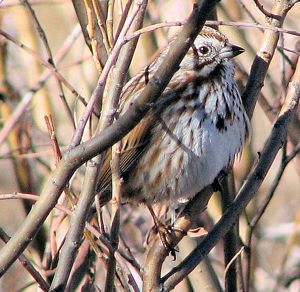
El Bosque |
White-crowned Sparrow
Zonotrichia leucophrys
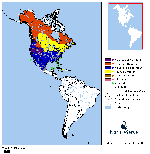
Enlarge Map
External Sites:
Cornell
USGS
Image Search | Adult (Upper Photo): Distinctive black and white stripes on head. Light colored bill. Clear breast and belly.
Juvenile (Lower Photo): Head stripes brown and gray. | 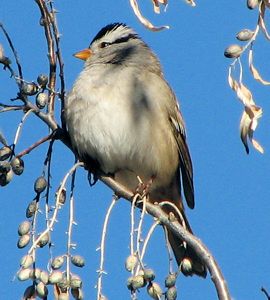
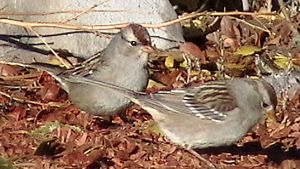 |
Dark-eyed Junco
Junco hyemalis
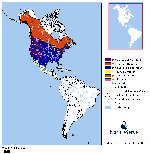
Enlarge Map
External Sites:
Cornell
USGS
Image Search | In winter, there are 5 sub-species of Dark-eyed Junco in our area. Many have a full black or gray hood. All have a dark eye set in dark plumage.
Almost always in flocks of 10-20 individuals. Identifiable by a very "dry" sounding "tck-tck" and by white showing on the sides of the tail, especially in flight.
Do a an Image Search (at left) to get an idea of the great variation in the plumage of this species. | 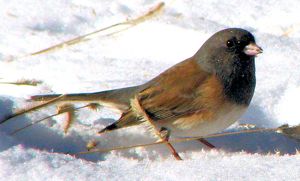
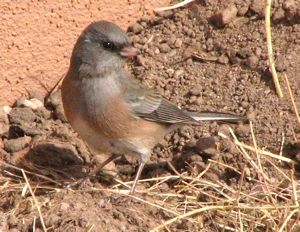 |
| Finches and Old World Sparrows |
House Finch
Carpodacus mexicanus
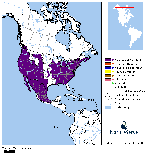
Enlarge Map
External Sites:
Cornell
USGS
Image Search | Often seen at feeders, this species is common in all habitats, especially agricultural areas.
Male (upper picture) is easily identified by red plumage on head, throat, breast and rump.
Female (lower photo) does not have red.
Both sexes have streaking on breast, belly and flanks. | 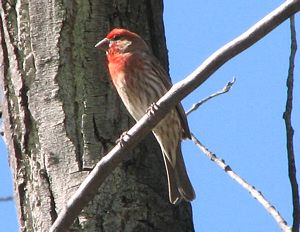
Arroyo La Mina
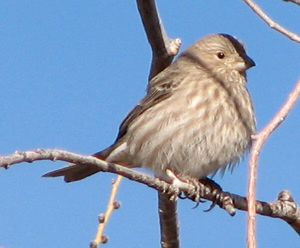
Arroyo La Mina |
American Goldfinch
Carduelis tristis
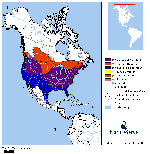
Enlarge Map
External Sites:
Cornell
USGS
Image Search | Female (Upper Photo)
Male (Lower Photo) | 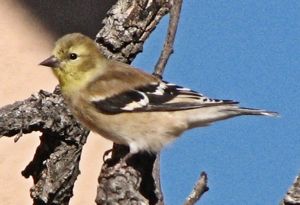
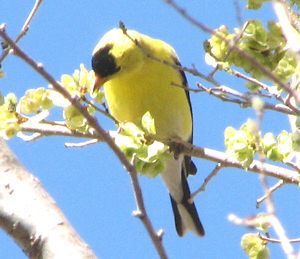 |
House Sparrow
Passer domesticus
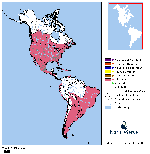
Enlarge Map
External Sites:
Cornell
USGS
Image Search | Common across the continental U.S., this species is generally found around human habitation.
The female (upper picture) is fairly plain with a weak, white eyebrow.
The male (lower picture) has black on the throat, a strong dark mask: often black in front of eye, reddish-brown (rufous) behind the eye.
Often in noisy flocks of 5-15 individuals. | 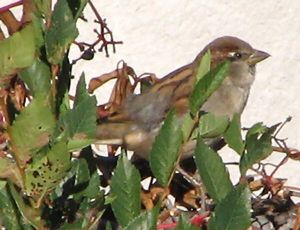
Embudo Valley Library, Dixon
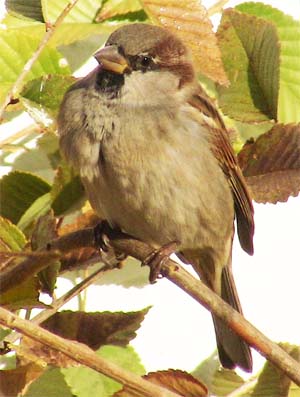
Nob Hill, Albuquerque
|










































































